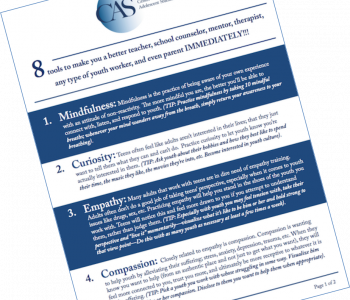

Sam Himelstein, PhD
Sam Himelstein is the founder and CEO of the Center for Adolescent Studies, Inc. He is passionate about working with youth and training the professionals that serve them.
3 Ways Movement Can Help Trauma-Impacted Youth
I was lucky enough on a number of occasions to attend a yoga teacher’s daylong retreat for the youth in the maximum-security unit at the juvenile hall where I used to work. I sat with them all day and participated, offering mindfulness tips when asked from the instructor. The youth learned physical techniques that were both soothing and strenuous, emphasizing that mindfulness of the body could occur both when relaxed and stressed.
This was a powerful way of teaching mindfulness without having to ask youth to close their eyes, enter a meditation, or do anything formal with their mind. The focus was on the body, and the youth (all of whom were highly traumatized) were able to stay present without serious triggering.
I’m not a yoga teacher, but I do a lot of movement-based interventions with my clients. If I discern that formal meditation may be too triggering, I often ask them, “How about we go for a short walk rather than sitting in this room? Sometimes talking while walking slowly can really help?” I get their consent and as long as I have access to a place where we can walk for some time, I take advantage of it.
“Mindful Walking Competition”
When I was running a volunteer program at a juvenile detention camp, I was given permission to take the youth around on hikes and teach them meditation and life skills, and help them get a break from incarcerated life.
It was quite an experience to see youth who’d been highly traumatized and locked up for significant amounts of time drop their guards and play like children. A game we played was deer and cougar, in which we taught the youth “fox-walking,” basically a form of mindful walking, so that all the cougars could sneak up on the deer. This was basically a version of red-light, green-light that was done in the woods.
From there we started having mindful walking competitions. The rules were simple. Everyone lined up at a starting line. A finish line was identified only about 10-15 feet from the starting line and everyone had to practice mindful walking, moving slowly and focusing on the sensations in their legs and feet.
This was the opposite of a race, since the last person to the finish line won. The only rules were that you had to be moving, you couldn’t stay still, and that you were to focus fully on your legs and bodily muscles.
This was a great way to get the youth interested in the idea of mindfulness, rather than jumping right into a formal, seated meditation program that they likely would have resisted.
Movement with Hypo-aroused Youth
In a previous post I mention a client named Jeannette (all names and identifying information have been changed), a young woman whose extensive trauma was triggered when she learned of the death of her estranged father.
“I just…. I can’t believe… Damn…”
I noticed that Jeannette’s language functioning was compromised because her brain was down regulating. Along with that, her face began to look spacey; the muscles in her face appeared to be flat, and she looked to be getting more dissociated. I took a controlled breath and intervened:
“Don’t worry about this therapy thing right now,” I said. “It can be hard to talk about these experiences. Let’s just listen to some music for a little while and see where that goes.”
She nodded with agreement as much as her nervous system allowed. She was clearly in the process of shifting down below the window of tolerance to a hypo-aroused, dissociated state.
I pulled up YouTube on the computer, gave her the headphones, and asked her the name of the first song she could think of. It was difficult for her to talk, but she managed to mention the name of a song. She listened to that song for about 3 minutes and slowly started to move her head with the rhythm and beat of the music. Then, she clicked on another song in the YouTube sidebar. After about three more songs, and 10-12 minutes of rhythmically moving her head and upper body to the music, she put the headphones down, turned to me, and said:
“I just can’t believe it. We were talking about getting in touch with him just a week ago. Damn.”
I noticed that she could coherently put a sentence together. It appeared she was back in the window of tolerance. The bilateral stimulation of the act of rhythmically moving to the rhythm and the beat of the music is what most likely helped her self-regulate.
If I had pressed her to talk about her feelings, or if I had tried leading her in a breathing meditation, that likely would have pushed her even farther below the window of tolerance. Instead, the bilateral stimulation from the rhythmic movement she engaged in while listening to the music regulated her central nervous system and brought her back into the window of tolerance, and the function of language came back. We were then able to process her experience. She was able to express her sadness, anger, and other emotions.
Movement with Hyper-Aroused Youth
Another of my clients, Joaquin, was triggered when talking about his father’s arrest and deportation. All of a sudden he aggressively got out of the desk chair and before I knew it, SMACK! With no warning he hit the classroom door with a closed fist as hard as he possibly could. He paced back and forth for a few moments, tears were starting to flow down his face, and the expression on his face that suggested he may not have been fully conscious of this outburst.
There was a basketball court right outside the empty classroom we were in and given that Joaquin was pacing, I managed to motion him to follow me outside the classroom to the basketball court and continue walking.
I picked up a basketball and handed it to him. He was still escalated, so I continued to motion forward as if to guide him to keep walking. He started dribbling the ball as he walked. At this point he was still breathing heavily, and tears were still running down his face.
After walking and dribbling the basketball for a while, Joaquin paused and said, “That shit was just so fucked up. It really made me hate this country.”
As with Jeannette, I noticed that Joaquin was able to coherently put a sentence together. That told me that higher functions of the brain were coming back online and that he was most likely shifting back within the window of tolerance. I led our walk back to the classroom and motioned him to keep the basketball when we went in.
“I ain’t never told that to anyone before,” he said as tears continued to fall down his cheeks. We spoke about his experiences for another 20 minutes or so; mostly I empathized with his feelings and expressed my support for him.
Conclusion
As you can see from these examples, there are three main benefits of movement as an intervention with traumatized youth:
- It’s a great introduction to mindfulness for those who may be skeptical about meditation;
- It can stimulate the central nervous system (CNS) when a youth is hypo-aroused (in a ‘freeze’ or ‘feigned death’ response); and
- It can channel excess energy when a youth is in a state of hyper-arousal (in a ‘fight’ or ‘flight’ stress response.
While I’m a strong advocate for mindfulness-based interventions, it isn’t always advisable to lead our students or clients in a formal, seated meditation. Different forms of movement can be powerful ways to help youth focus on the present-moment and understand how to self-regulate when they’re experiencing intense emotions.
Join the FREE Resilience Community for Helping Professionals to learn more about trauma-informed care, resilience, mindfulness, building relationships, and more! Our community features self-paced courses, a monthly live Zoom call, a weekly live meditation, and an online platform to connect with other providers/professionals in your field.
Related Posts
9 Guidelines for Teaching Trauma-Informed Mindfulness to Teens
Compassion Can Help You Work with Trauma-Impacted Youth

